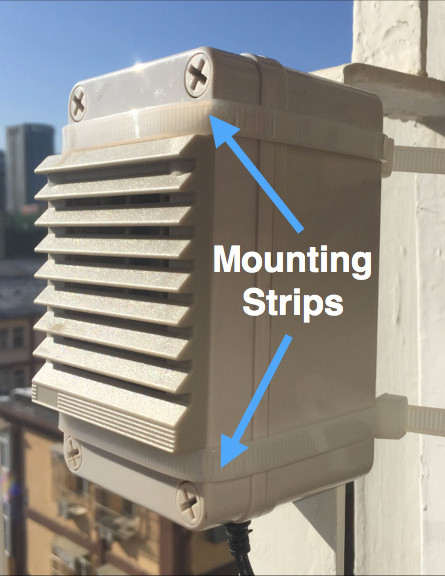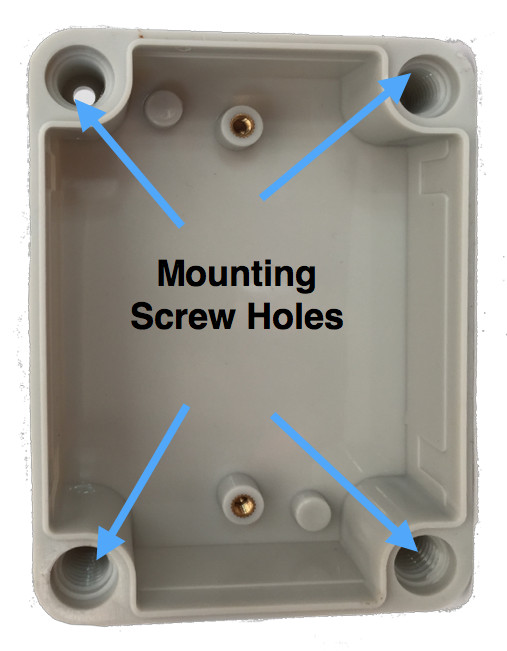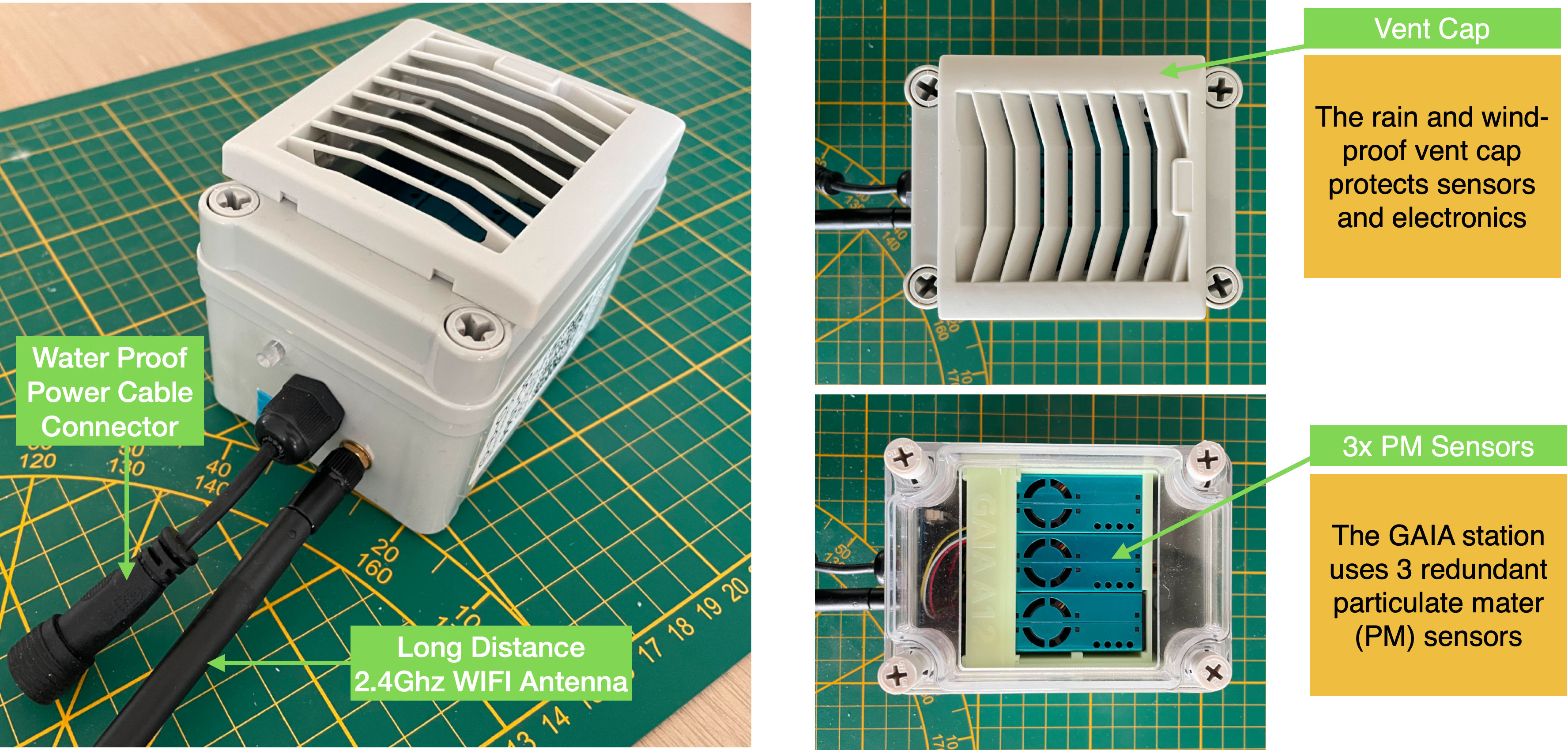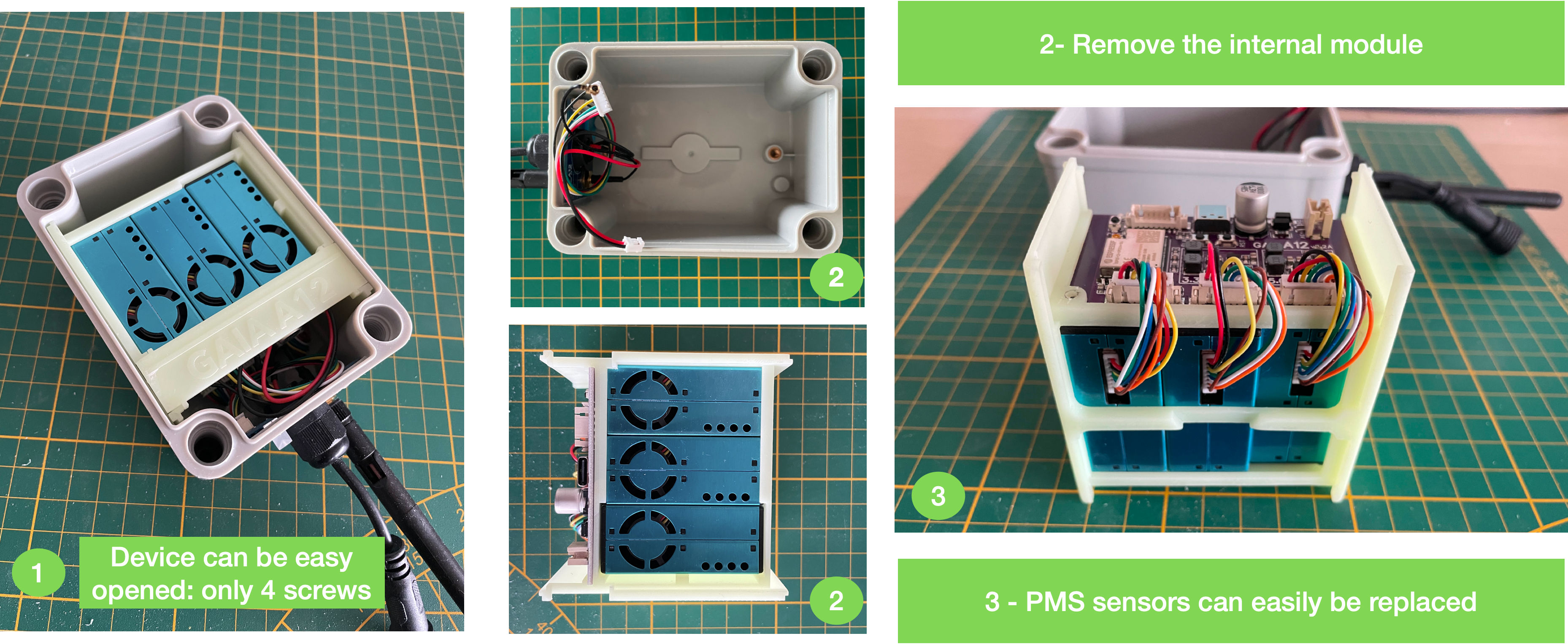ملخص

وزن: 380g
GAIA A12 عبارة عن محطة مليئة بأجهزة الاستشعار:
- أجهزة استشعار جودة الهواء للجسيمات: 3x PMS 5003 3xPMS
- أجهزة استشعار ثاني أكسيد الكربون: Sensiron SCD4x CO2
- مستشعر الطقس: درجة الحرارة والرطوبة MET
- RGB LED للإشارة إلى تلوث الهواء البصري في الوقت الحقيقي. LED
- الاتصال عبر WIFI، مع هوائي خارجي. WIFI
- مصدر طاقة مقاوم للماء: موصل DC5.5/2.1، متوافق مع USB. 5V/1A
- تخزين اختياري لبطاقة SD للتشغيل خارج الشبكة.
يستخدم GAIA A12 3 أجهزة استشعار لجودة الهواء زائدة عن الحاجة لضمان أفضل جودة للبيانات: يقوم نظامه بربط البيانات من جميع أجهزة الاستشعار بشكل مستمر لاكتشاف أي بيانات غير طبيعية وتصحيحها تلقائيًا.
يتكون GAIA A12 من غلاف بلاستيكي ABS مقاوم للأشعة فوق البنفسجية ABS وغطاء مقاوم للمطر LID، مما يجعله مثاليًا للاستخدام الخارجي لفترات طويلة.
تأتي محطة GAIA A12 مع الملحقات التالية:
- كابل الطاقة: كابلات مقاومة للماء بطول 10 أمتار (2x5 م).
- مصدر الطاقة: محول طاقة USB 5 فولت/1 أمبير.
- أشرطة التثبيت والمسامير.
سعر
تكلفة GAIA A12 200
وبدلاً من ذلك، يمكن أيضًا الحصول على المحطة مقابل 100 إذا تم الدفع سنويًا، أو 10 إذا تم الدفع شهريًا: ثم نرسل لك محطة جديدة تمامًا كل عامين مجانًا (باستثناء تكاليف الشحن). يعد تجديد المحطة أمرًا مهمًا بالنسبة لنا لضمان أعلى جودة استشعار لمحطتك. لاحظ أننا نطلب إيداع 50 للمحطة المستأجرة.
ملخص
| أجهزة الاستشعار | مستشعر الجسيمات (PM). | بيإم 2.5 ، بيإم 10 و بيإم 1.0 |
| أجهزة استشعار PM زائدة عن الحاجة | نعم (×3) | |
| مستشعر ثاني أكسيد الكربون | نعم | |
| مستشعر الطقس | درجة الحرارة والرطوبة | |
| المؤشرات البصرية | RGB LED | نعم |
| الاتصال | واي فاي | نعم (2.4 جيجا) |
| هوائي خارجي | نعم، 3 ديسيبل | |
| مزود الطاقة | مزود الطاقة | نعم، باستخدام USB 5V DC القياسي |
| سلك الطاقة | كابل مقاوم للماء بطول 10 أمتار (33 قدمًا). | |
| تخزين البيانات والبث | النشر | نعم، يتم بثه على موقع aqicn.org وwaqi.info |
| البيانات التاريخية | نعم، يمكن الوصول إليه عبر موقع الويب أو واجهة برمجة التطبيقات (API). | |
| تخزين بطاقة SD | اختياري، مقابل 50 الإضافية | |
| صيانة | إكتشاف عيب خلقي | نعم |
| الصيانة عن بعد | نعم | |
| التسعير | تكلفة المنتج | دفعة لمرة واحدة: 200 الدفعة السنوية: 100 + الإيداع: 50 الدفعة الشهرية: 10 + الإيداع: 50 |
محتوى حزمة GAIA A12:

1: كابل طاقة DC5.5 مقاوم للماء بطول 2 × 5 أمتار
3: هوائي واي فاي خارجي
4: مصدر طاقة USB 5 فولت/1 أمبير
5: كابل طاقة USB <-> DC5.5
6: لاصق التركيب
7: شرائط الفم
يرجى ملاحظة أن شاحن USB المتضمن في العبوة يتم تخصيصه وفقًا للمنطقة التي تتواجد فيها.
الطلب والاستفسار
املأ النموذج أدناه للحصول على عرض أسعار بما في ذلك تكلفة الشحن.
أسئلة مكررة:
- الدفع: يمكن أن يتم ذلك باستخدام أي بطاقة ائتمان عادية.
- الخصم: خصم 10% عند طلب 5 قطع، 20% عند طلب 10 قطع أو أكثر.
- محول التيار المستمر: يتم شحن المنتجات مع محولات قابس الطاقة المحلية (مصدر طاقة USB) للولايات المتحدة والاتحاد الأوروبي والاتحاد الأفريقي والمملكة المتحدة.
 Mounting with straps
Mounting with straps 


